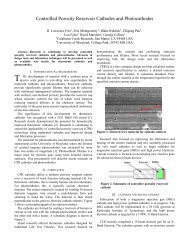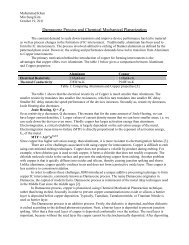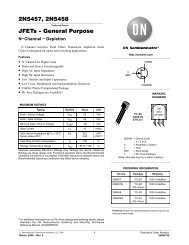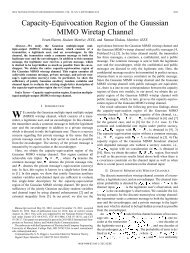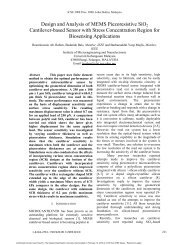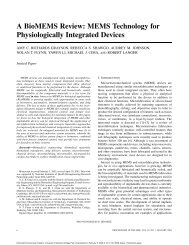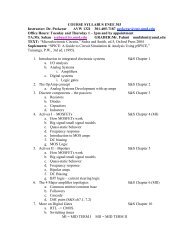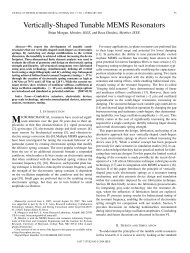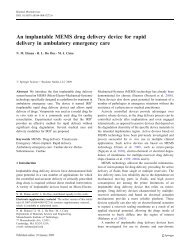Realization of Verilog HDL Computation Model - ECE
Realization of Verilog HDL Computation Model - ECE
Realization of Verilog HDL Computation Model - ECE
You also want an ePaper? Increase the reach of your titles
YUMPU automatically turns print PDFs into web optimized ePapers that Google loves.
<strong>Realization</strong> <strong>of</strong> <strong>Verilog</strong> <strong>HDL</strong> <strong>Computation</strong> <strong>Model</strong><br />
CSCI 320 Computer Architecture<br />
By Dr. Daniel C. Hyde<br />
Department <strong>of</strong> Computer Science<br />
Bucknell University<br />
October 1997<br />
Copyright 1997<br />
By Daniel C. Hyde
1. Introduction<br />
<strong>Realization</strong> <strong>of</strong> <strong>Verilog</strong> <strong>HDL</strong> <strong>Computation</strong> <strong>Model</strong> Page 2<br />
<strong>Verilog</strong> <strong>HDL</strong> is a hardware description language. The computer industry uses <strong>Verilog</strong> <strong>HDL</strong> for design<br />
<strong>of</strong> digital systems. From the <strong>Verilog</strong> code, industry uses automated tools to generate integrated circuit<br />
masks needed in the fabrication <strong>of</strong> integrated circuit (IC) chips.<br />
In this course, a subset <strong>of</strong> the <strong>Verilog</strong> language will be used to describe and develop computer architectural<br />
concepts using a model <strong>of</strong> computation at the register transfer level. The purpose <strong>of</strong> this handout<br />
is to describe this model <strong>of</strong> computation and demonstrate how the model can be realized in digital circuits.<br />
2. Example Simple Computer Using Register Transfer Level<br />
Assume we have a very simple computer, with 1024 words <strong>of</strong> memory (Mem) each 32-bits wide, a<br />
memory address register (MA), a memory data register (MD), an accumulator (AC), an instruction register<br />
(IR) and a program counter (PC). Since we have 1024 words <strong>of</strong> memory, the PC and MA need to be<br />
10-bits wide.<br />
We can declare the registers and memory in <strong>Verilog</strong> as the following:<br />
reg [0:31] AC, MD, IR;<br />
reg [0:9] MA, PC;<br />
reg [0:31] Mem [0:1023];<br />
We assume a digital system can be viewed as moving vectors <strong>of</strong> bits between registers. This level <strong>of</strong><br />
abstraction is called the register transfer level. For example, we may describe in <strong>Verilog</strong> an instruction<br />
fetch by four register transfers:<br />
// instruction fetch<br />
#1 MA
3. Our <strong>Computation</strong>al <strong>Model</strong><br />
<strong>Realization</strong> <strong>of</strong> <strong>Verilog</strong> <strong>HDL</strong> <strong>Computation</strong> <strong>Model</strong> Page 3<br />
Register transfers are general. In fact, we can view a computation as a specific class <strong>of</strong> register transfers.<br />
Definition: A computation consists <strong>of</strong> placing some Boolean function <strong>of</strong> the contents <strong>of</strong><br />
argument registers into a destination register.<br />
That is, in this course a computation is a register transfer. In computer design, register transfers are very<br />
important. They are everywhere -- in arithmetic logic units (ALU), control units (CU), memory subsystems,<br />
I/O devices and interconnection networks.<br />
Observe from the above definition that we need only Boolean functions. We don’t need arithmetic or<br />
higher order functions. To realize the Boolean functions, we design combinational logic circuits, for example,<br />
an adder, from AND, OR and NOT gates.<br />
Boolean functions have no concept <strong>of</strong> time. To incorporate the passage <strong>of</strong> time in our model, we define<br />
computing as a sequence <strong>of</strong> several register transfers where each transfer takes one clock period.<br />
Definition: Computing is a sequence <strong>of</strong> computations.<br />
Therefore, the above <strong>Verilog</strong> code for the LOAD instruction has seven computations or register transfers.<br />
We would say the performing <strong>of</strong> a LOAD instruction is computing because we do seven computations<br />
one after the other, in sequential order.<br />
A major part <strong>of</strong> the description <strong>of</strong> a computer is a plan defining each register transfer, or computation,<br />
and specifying the order and timing in which these register transfers will take place.<br />
How does this view <strong>of</strong> computation compare with other definitions you may have seen? One way to<br />
view computation is as a change in state. Here in a very practical way, we are viewing computation as a<br />
change in the state <strong>of</strong> hardware registers. For example, the MA changes state in the following transfer.<br />
#1 MA
means the four flip flops as shown:<br />
D<br />
C A<br />
Q Q<br />
D<br />
C A<br />
Q Q<br />
<strong>Realization</strong> <strong>of</strong> <strong>Verilog</strong> <strong>HDL</strong> <strong>Computation</strong> <strong>Model</strong> Page 4<br />
D<br />
C A<br />
Q Q<br />
D<br />
C A<br />
Q Q<br />
0 1 2 3<br />
Fig. 1 Register A is four D flip flops.<br />
A computation is a register transfer. Here are two computations and their associated declaration.<br />
reg [0:3] A, B;<br />
#1 A
B
<strong>Realization</strong> <strong>of</strong> <strong>Verilog</strong> <strong>HDL</strong> <strong>Computation</strong> <strong>Model</strong> Page 6<br />
A bank <strong>of</strong> ANDs is needed for each argument register and a bank <strong>of</strong> ORs for the input into the D input <strong>of</strong><br />
the destination flip flops. A technique called “busing” would reduce the number <strong>of</strong> AND and OR gates<br />
needed. However, we will ignore busing.<br />
Observe that the data unit does not contain when the computations are done. The sequencing <strong>of</strong> the<br />
three is done by the two control signals supplied by the control unit.<br />
Here is another example <strong>of</strong> a computation and how we model the <strong>Verilog</strong> code as a digital logic circuit:<br />
reg [0:3] A, B, X;<br />
A
<strong>Realization</strong> <strong>of</strong> <strong>Verilog</strong> <strong>HDL</strong> <strong>Computation</strong> <strong>Model</strong> Page 7<br />
the “+” operator by an ADDER circuit. Usually, we also design special combinational circuits for increment<br />
by one (INC) and decrement by one (DEC). For example, we would replace the + operator used in<br />
the instruction fetch<br />
with<br />
#1 PC
system clock<br />
single pulse<br />
no. 1<br />
no. 2<br />
no. 3<br />
time<br />
clock period<br />
Fig. 7 Timing diagram <strong>of</strong> control signal lines.<br />
<strong>Realization</strong> <strong>of</strong> <strong>Verilog</strong> <strong>HDL</strong> <strong>Computation</strong> <strong>Model</strong> Page 8<br />
Notice that the pulse, called the control pulse, is delayed one clock period as it raises the control lines<br />
for the three computations. What kind <strong>of</strong> circuit can delay a pulse for one clock period? We can use our<br />
old friends the trailing edge triggered clocked D flip flops.<br />
single<br />
pulse<br />
generator<br />
system clock<br />
D<br />
Q<br />
Q<br />
Q<br />
no. 1 D no. 2 D no. 3<br />
C<br />
A
single<br />
pulse<br />
generator<br />
system clock<br />
D<br />
C<br />
<strong>Realization</strong> <strong>of</strong> <strong>Verilog</strong> <strong>HDL</strong> <strong>Computation</strong> <strong>Model</strong> Page 9<br />
A
end<br />
in<br />
s<br />
~s<br />
system clock<br />
D<br />
Q<br />
L3 D L4<br />
C<br />
Q<br />
<strong>Realization</strong> <strong>of</strong> <strong>Verilog</strong> <strong>HDL</strong> <strong>Computation</strong> <strong>Model</strong> Page 10<br />
A
3 pulses in<br />
synchronizing<br />
unit<br />
system clock<br />
<strong>Realization</strong> <strong>of</strong> <strong>Verilog</strong> <strong>HDL</strong> <strong>Computation</strong> <strong>Model</strong> Page 11<br />
1 pulse out<br />
Fig. 13 Portion <strong>of</strong> the hardware control unit for a three-way join.<br />
Rule 7: For a join, the n control pulses are synchronized by a special circuit which passes along one<br />
control pulse after all n pulses have arrived.<br />
This concludes the design <strong>of</strong> the hardwired control unit.<br />
6. Speeding Up the Machine<br />
Fast performance is many times important, especially with CPUs. Many times, register transfers can<br />
be performed in the same clock period. For example, given the following register transfers:<br />
#1 A
<strong>Realization</strong> <strong>of</strong> <strong>Verilog</strong> <strong>HDL</strong> <strong>Computation</strong> <strong>Model</strong> Page 12<br />
Usually, we write our design using #1s liberally. After we have tested the design and are confident<br />
that it works, then we carefully analyze the code and remove the #1s one at a time.<br />
7. Conclusions<br />
Given a complicated digital system description in <strong>Verilog</strong>, translating the <strong>Verilog</strong> code to the digital<br />
circuit becomes very tedious and time consuming. Hence, the utility <strong>of</strong> automated tools to perform this<br />
task. From the few examples shown, you should begin to see how the task <strong>of</strong> translating <strong>Verilog</strong> nonblocking<br />
assignment statements, e. g., A



